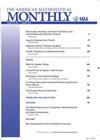Reviews
IF 0.4
4区 数学
Q4 MATHEMATICS
引用次数: 0
Abstract
The most revelatory experience of my undergraduate mathematics degree was a writing course offered by James Vick. Well on his way to becoming a vice president in the University of Texas administration, Vick still managed to teach the occasional class. This one, “Proofs, Conjectures, and Controversies,” showed us that mathematics was not always as absolute as implied in our other courses. In particular, there is not always consensus about what constitutes a valid proof and what tools are allowed. One example of controversy was the 1976 computer-assisted proof of the four color theorem, establishing that the countries of every map can be colored with at most four colors so that no two neighboring countries are colored the same. The class readings included the recent Dover edition of Saaty and Kainan’s book [18] on the “assaults and conquest” of that graph theory problem and Leonard Gillman’s celebrated guide to mathematical writing [5]. What an honor to learn about recent and contentious research developments while developing skills in mathematical exposition. The year 1976 was an important year for both the United States and graph theory. In that year of the American bicentennial, Kenneth Appel and Wolfgang Haken of the University of Illinois solved Francis Guthrie’s 1852 four color conjecture. This was one of the rare mathematical results to be mentioned (eventually) in The New York Times [19, p. 209]. Another milestone for graph theory that year was the publication of the first book on its history, Graph Theory 1736–1936 by Norman Biggs, Keith Lloyd, and Robin Wilson [2]. That book opened a sort of trilogy on the history of graph theory, all involving the talented and prolific expositor Robin Wilson. The second book was a 2002 solo effort Four Colors Suffice [19]. The third book, based on the 2012 dissertation of David Parks [16] and also featuring John Watkins, focuses on the period 1876–1976 with an emphasis on US and Canadian contributions to the field. This review will focus on the 2023 book while also discussing it in relation to its two predecessors.评论
我本科数学学位中最具启发性的经历是詹姆斯·维克开设的写作课程。在成为得克萨斯大学行政部门副校长的路上,维克仍然设法偶尔教一些课。这篇题为“证明、猜想和争议”的文章向我们表明,数学并不总是像其他课程中所暗示的那样绝对。特别是,对于什么构成有效证明以及允许使用什么工具,并不总是达成共识。争议的一个例子是1976年计算机辅助证明的四色定理,该定理规定每张地图上的国家最多可以用四种颜色着色,因此没有两个邻国的颜色相同。课堂阅读包括萨蒂和凯南关于“攻击和征服”图论问题的书[18]的多佛版,以及伦纳德·吉尔曼著名的数学写作指南[5]。在发展数学阐述技能的同时,能了解到最近有争议的研究进展,我感到非常荣幸。1976年对美国和图论来说都是重要的一年。在美国二百周年的那一年,伊利诺伊大学的Kenneth Appel和Wolfgang Haken解决了Francis Guthrie 1852年的四色猜想。这是《纽约时报》[19,第209页](最终)提到的罕见数学结果之一。这一年图论的另一个里程碑是诺曼·比格斯、基思·劳埃德和罗宾·威尔逊出版了关于其历史的第一本书《1736-1936年图论》[2]。这本书开启了图论史的三部曲,所有这些都涉及才华横溢、多产的阐释家罗宾·威尔逊。第二本书是2002年的个人作品《四种颜色就足够了》[19]。第三本书以David Parks[16]2012年的论文为基础,约翰·沃特金斯(John Watkins)也参与其中,重点讲述了1876-1976年这一时期,强调了美国和加拿大对该领域的贡献。这篇综述将聚焦于2023年的这本书,同时也将讨论它与前两本书的关系。
本文章由计算机程序翻译,如有差异,请以英文原文为准。
求助全文
约1分钟内获得全文
求助全文
来源期刊

American Mathematical Monthly
Mathematics-General Mathematics
CiteScore
0.80
自引率
20.00%
发文量
127
审稿时长
6-12 weeks
期刊介绍:
The Monthly''s readers expect a high standard of exposition; they look for articles that inform, stimulate, challenge, enlighten, and even entertain. Monthly articles are meant to be read, enjoyed, and discussed, rather than just archived. Articles may be expositions of old or new results, historical or biographical essays, speculations or definitive treatments, broad developments, or explorations of a single application. Novelty and generality are far less important than clarity of exposition and broad appeal. Appropriate figures, diagrams, and photographs are encouraged.
Notes are short, sharply focused, and possibly informal. They are often gems that provide a new proof of an old theorem, a novel presentation of a familiar theme, or a lively discussion of a single issue.
Abstracts for articles or notes should entice the prospective reader into exploring the subject of the paper and should make it clear to the reader why this paper is interesting and important. The abstract should highlight the concepts of the paper rather than summarize the mechanics. The abstract is the first impression of the paper, not a technical summary of the paper. Excessive use of notation is discouraged as it can limit the interest of the broad readership of the MAA, and can limit search-ability of the article.
 求助内容:
求助内容: 应助结果提醒方式:
应助结果提醒方式:


